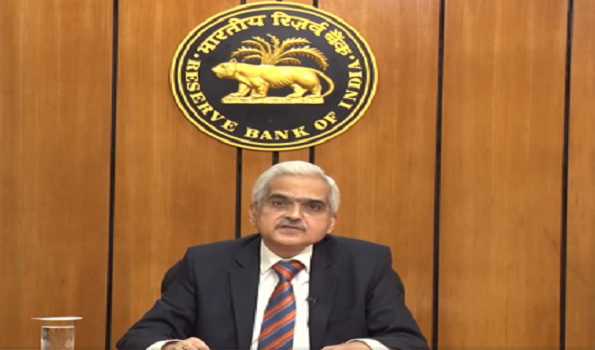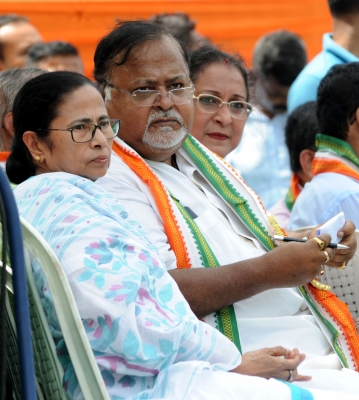
New Delhi/Mumbai: Amid the global scare of new variant of Coronavirus Omicron posing downside risks to the economy, the Reserve Bank of India (RBI) on Wednesday maintained status quo on key policy rates providing cushion to the economy which has been on the recovery path clocking 8.4% growth in July-September quarter (Q2) of the current fiscal.
Consequently, the policy repo rate and reverse repo rate remain unchanged at 4% and 3.35% respectively. Repo rate refers to the rate at which commercial banks borrow from the central bank. Reverse repo rate is the rate at which RBI borrows from banks. On expected lines, the central bank retained accommodative stance to support the recovery process.
“Based on an assessment of the macroeconomic situation and outlook, the MPC voted unanimously to maintain status quo with regard to the policy repo rate and by a majority of 5 to 1 to retain the accommodative policy stance. Consequently, the policy repo rate remains unchanged at 4%, and the stance remains accommodative as long as necessary to revive and sustain growth on a durable basis and continue to mitigate the impact of COVID19 on the economy, while ensuring that inflation remains within the target going forward,” said RBI Governor Shaktikanta Das after three-day meet of the six-member MPC.
Das heads the key panel which is primarily tasked with maintaining price stability in the country and helping formulate the monetary policy. The RBI has retained its growth forecast and expects the economy to grow at 9.5% in the current financial year.
Noting that downside risks have risen with the emergence of Omicron and renewed surges of Covid-19 infections in a number of countries, the RBI Governor said that headwinds continue to be posed by elevated international energy and commodity prices, potential volatility in global financial markets due to a faster normalisation of monetary policy in advanced economies and prolonged global supply bottlenecks.
“Overall, the recovery that had been interrupted by the second wave of the pandemic is regaining traction, but it is not yet strong enough to be self-sustaining and durable. This underscores the vital importance of continued policy support,” he said.
The RBI Governor noted that the country is now better prepared to deal with the invisible enemy of Covid-19. He stated that several sectors of the economy had crossed pre-pandemic level of output and inflation is broadly aligned with the target of 4% barring short-lived spikes.
Das said that the inflation trajectory is likely to be in line with the RBI’s earlier projections and price pressures may persist in the immediate term. Further, vegetable prices are expected to see a seasonal correction with winter arrivals in view of bright prospects for the Rabi crop.
Supply side interventions by the government have limited the fallout of continuing high international edible oil prices on domestic prices, he said.
He said that over the rest of the year inflation prints are likely to be somewhat higher as base effects turn adverse. However, it is expected that headline inflation will peak in Q4 of the current financial year and soften thereafter.
He stated that CPI inflation is projected at 5.3% for 2021-22.
“This consists of 5.1% in Q3 and 5.7% in Q4 of FY22 with risks broadly balanced. CPI inflation is then expected to ease to 5% in Q1 FY22-23 and stay at 5% in Q2 of FY22-23,” he announced. Das also said that external financing requirements are very modest and strong buffers should withstand any global spill-overs.
Public finances have been strengthened by buoyant tax revenues. The central and state governments and the RBI have mobilised policy actions on an unprecedented scale and scope to bring about this outcome, he said.
Economists, industry and public policy experts hailed the RBI decision to hold on rates and said that the monetary policy statement is on expected lines. “Overall, the MPC has continued with the assurance of continuation of accommodative stance to support and nurture the growth recovery.
It has also indicated the continuation of liquidity normalization keeping in view the requirements of the market,” M. Govinda Rao Chief Economic Adviser, Brickwork Ratings.
Shishir Baijal, Chairman & Managing Director, Knight Frank India said that the low interest rate regime has been instrumental in reviving the real estate sector in the last six quarters through their systematic approach.
“RBI’s efforts, along with other demand stimulant measures, have helped revive demand that had been languishing for close to 7 years prior to 2020. The continuance of the accommodative stance will help further the cause for the sector,”Baijal said.
Some of the market watchers termed the monetary policy statement as non-event suggesting that attention has now shifted to February announcement.
“Going forward, we fear that real GDP growth could be lower than the RBI projections, with inflation falling broadly in line. Along with the rising threat from the Omicron variant, there is a possibility that a hike in reverse repo could be postponed further to April 2022,” said Nikhil Gupta, Chief Economist, Motilal Oswal Financial Services.
Suvodeep Rakshit, Senior Economist, Kotak Institutional Equities said that the policy is broadly more dovish-than-expected possibly given the uncertainty from the new Covid variant. “If the Omicron variant is benign, we expect reverse repo hike of around 20 bps possible in the February policy and tad more aggressive liquidity withdrawal,” he said.






